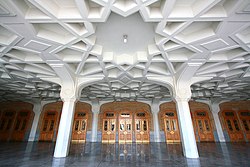Vault (architecture)

A Vault (French. voute, Italian. volta, German. Gewölbe, Polish. sklepienie, Spanish. bóveda) is an architectural term for an arched form used to provide a space with a ceiling or roof.
Vault in ancient time[change | change source]
Long ago, in places like Mesopotamia and Egypt, they used simple vaults made of stones to build things like tombs and ziggurats. Then, the Romans got really good at making vaults. They built big things like the Colosseum using them, showing how clever they were at engineering. The Byzantine Empire, in places like Constantinople, also used vaults with fancy designs, like the Hagia Sophia with its pretty mosaics.
In India, Islamic builders made vaults with big domes and detailed patterns, influenced by Persian and Byzantine styles, as seen in the Taj Mahal. Later in Europe, during the Gothic time, people started using pointed arches and ribbed vaults in cathedrals, like Notre-Dame in Paris. In Italy, during the Renaissance, Filippo Brunelleschi made a famous dome for Florence Cathedral with a vaulted ceiling. Then, in the Baroque and Rococo times, fancy vaulted ceilings became popular again in Europe's palaces and churches.
Types of Vaults[change | change source]
The vaults can be classified on the basis of its structureː[1]
- Barrel Vaultsː Barrel vaults are a type of architectural feature known for their long, curved shape that looks like a barrel or a tunnel. They stretch across a large area, offering both support and a distinctive look. Barrel vaults are good at spreading out weight and keeping structures stable over a big space.
- Dome Vaultsː Dome vaults are unique architectural features using rounded or hemispherical structures to cover spaces. These ceilings, often found in religious buildings and palaces, serve as central focal points in interiors.
- Groin Vaultsː A groin vault forms where two barrel vaults intersect at right angles, creating an X-shaped pattern called the groin. This design offers structural strength and has been used in many architectural styles over time. Inspired by various historical styles like Gothic and Renaissance, they're now popular in large interior spaces like grand halls or churches, creating dramatic, open areas.
- Ribbed Vaultsː Ribbed vaults are architectural vaults with ribs or arches extending across their surface, adding both decoration and structural support. These ribs distribute weight and allow for intricate designs. From medieval cathedrals to modern buildings, ribbed vaults impress with their beauty and engineering.
- Fan Vaultsː Fan vaults are unique architectural features with concave ribs spreading out from a central point, forming a fan-like pattern. They're typical in English Gothic architecture, popular during the late Gothic period in England, especially in the 15th and early 16th centuries.
- Cloister Vaultsː The cloister vault is made up of intersecting barrel vaults, creating a grid pattern over the cloister's open galleries. The ribs provide structural support and visual appeal, seen in Renaissance buildings and European cathedrals and monasteries.
- ↑ Pramod, Gopika (2023-12-24). "Types of Vaults in Architecture: Structure and Architecture Style". The Architects Diary. Retrieved 2024-05-08.
